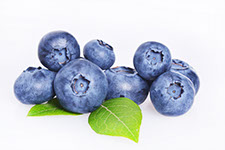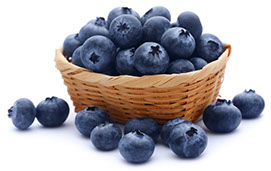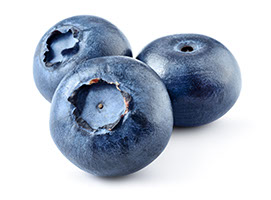Overview
Compatibility & Temperature
Grade Tolerances
Nutrition Information
Blueberries
Blueberries
The blueberry is one of the few fruits native to North America. They were gathered by Native
Americans from bogs and forests, and consumed fresh or preserved. Additionally, blueberries were used for medicinal purposes, as dye for baskets and cloth, and dried to use as a spice.
Sources: U.S. Highbush Blueberry Council, Producepedia.com
Types, Varieties & Cuts
The most common types of blueberries are Northern highbush, lowbush (wild) and rabbiteye. Northern highbush blueberries are most common in North America, and include many different varieties. Thirty- eight U.S. states produce blueberries, but six account for the majority of highbush crops: Michigan, New Jersey, Oregon, North Carolina, Georgia, and Washington. British Columbia is the primary producer of highbush blueberries in Canada. Low- bush or wild blueberries are used primarily in food processing and grown in Maine and
eastern Canada. Requiring minimal management and indigenous to the area, wild blueberries are naturally resistant to many pests. Rabbiteye blueberries are commonly grown in the South and have no major pests associated with them.
Sources: Texas A&M University, University of Maine Cooperative Extension, USDA
Cultivation, Storage & Packaging
Preharvest
Blueberry plants perform well in acidic, sandy, well drained soil. Roots are fibrous, shallow, and sensitive to soil compaction and poor drainage. High organic matter in- creases the water capacity and improves aeration. Drought conditions adversely affect growth; crops benefit from irrigation during dry seasons.
Postharvest
 Blueberries are easily damaged by rough handling and adverse temperatures. Manual harvesting occurs over the course of three to four weeks as the berries ripen.
Blueberries are easily damaged by rough handling and adverse temperatures. Manual harvesting occurs over the course of three to four weeks as the berries ripen.
Mechanical harvesting tends to cause excessive damage; these berries are often considered unfit for the fresh market and sold for processing or freezing.
Regular pruning of blueberry plants is required to produce high yields and per- formed when the plants dormant, in either late fall, winter, or early spring. Early spring pruning is recommended because in- jury sustained during winter months can be identified and removed.
Blueberries should be cooled within 4 hours of harvest to lower the respiration rate and slow the ripening process. A con- trolled atmosphere with 15 to 20% carbon dioxide and 5 to 10% oxygen reduces mold growth and other decay-causing organisms.
Sources: Michigan State University Extension, North Carolina Cooperative Extension Service, UC Davis Postharvest website
Good Arrival Guidelines/Tolerances
Good arrival guidelines in the United States permit 15% total average defects, 8% serious and 3% decay upon arrival at con- tract destination after five days in transit.
Good arrival guidelines in Canada permit 8% total defects allowed by grade, 3%* total permanent defects (*no more than 1%foreign material), 3% maximum for any single permanent grade, 8% maximum condition defect and 3% maximum decay (additional tolerances apply).
Recommended transit temp is 31 to 32oF.
Sources: DRC, PACA, USDA

Nutrition Facts
Serving Size 1 cup
Amount Per Serving
Calories from Fat 4Calories 83
% Daily Values*
Total Fat 0.48g 1%
Saturated Fat 0.041g 0%
Polyunsaturated Fat 0.212g
Monounsaturated Fat 0.068g
Cholesterol 0mg 0%
Sodium 1mg 0%
Potassium 112mg
Total Carbohydrate 21.01g 7%
Dietary Fiber 3.5g 14%
Sugars 14.44g
Protein 1.07g
Vitamin A 2% Vitamin C 24%
Calcium 1% Iron 2%
* Percent Daily Values are based on a 2000 calorie diet. Your daily values may be higher or lower depending on your calorie needs.
Nutrition Values are based on USDA Nutrient Database SR18


Century Farms International, Inc.
10957 NW 123rd Street Medley, FL 33178
Office: 305-436-7971 Fax: 305-436-7968




